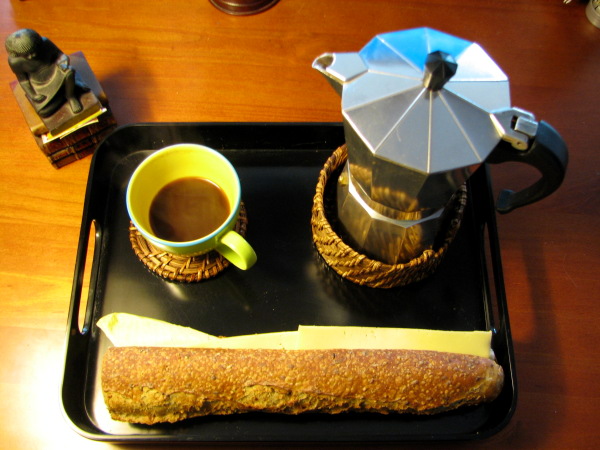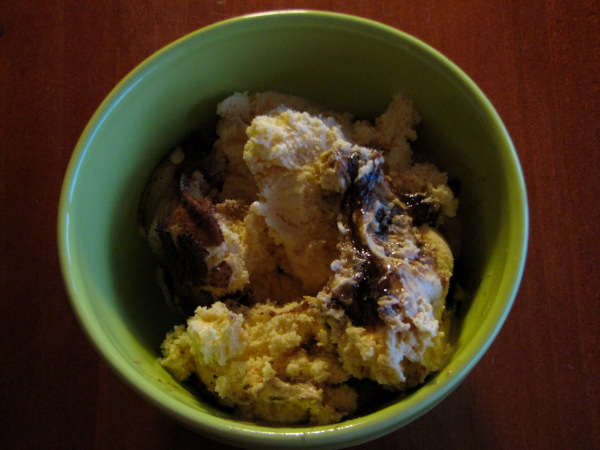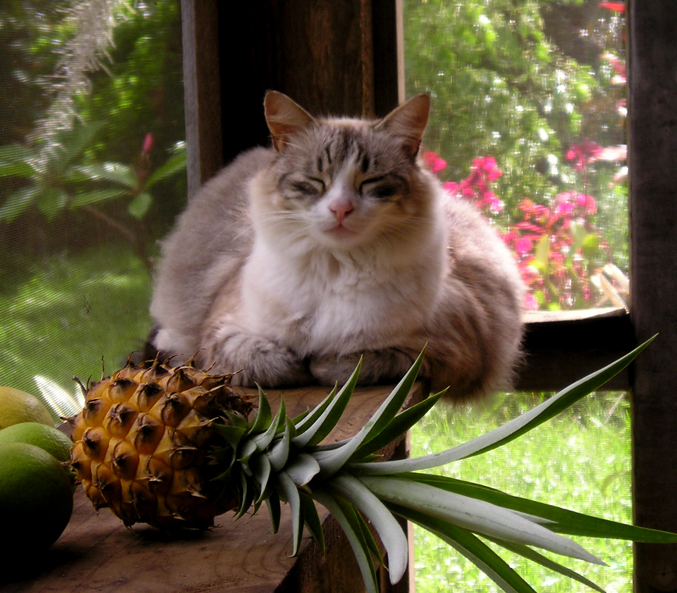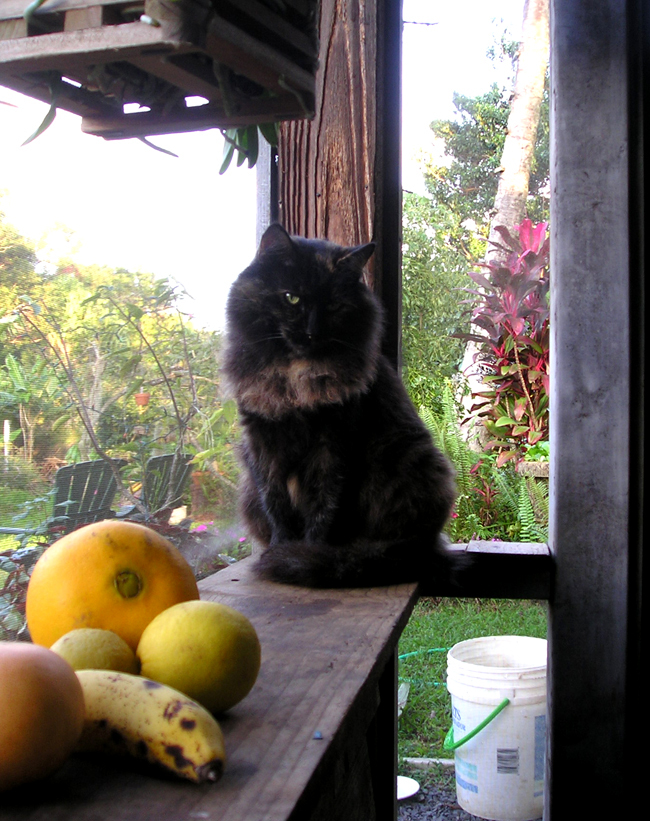
From my friend in Perpignan, here’s another installment in the series “What they’re eating in the south of France.” Above: a breakfast/lunch baguette with cheese and salad, with coffee.
Category: Food
Yum… Fritters…
I think I found a use for those dry hummus mixes. They’re healthy, and they store well, and they make good earthquake or ice storm food for the cupboard, but they’re terrible hummus. Only fresh hummus is worthwhile. However, these mixes make a good binding for vegetable fritters. The fritter above is chopped broccoli, chopped cauliflower (both cooked until just tender) and chopped onions. The vegetables are bound with the instant hummus, and I added egg to make the fritters set from the heat of the frying pan. Fritters are real nice to have when you’ve just got to have something a bit crunchy and fried. These fritters are low carb, low glycemic, and cruciferous to boot. It shouldn’t be hard to make a vegan version if you can find a suitable substitute for the egg.
This just in…
Continuing in the category of who’s eating what where, here’s another shot of what they’re eating on Maui, with another cat as bonus. This is Phatboi, who I suspect got fat off of something other than pineapples and limes.
Send me your who’s-eating-what-and-where photos! But please, mind the quality of your photography. Whatever your subject is, get up as close to it as possible and frame it nicely. Attend to your foreground and background. There’s a world of difference between a photograph and a snapshot. One is art. The other is, well, practice until you learn to make art with your camera.
Homemade sauerkraut — the first tasting
The sauerkraut was put into the crocks on Oct. 29, and the first tasting was yesterday, Dec. 3, when my mother and brother were here for lunch. At that point the sauerkraut was a little less than five weeks old. I would say that it is good sauerkraut, but not the best I’ve ever tasted. The flavor was a bit too mild, and the cabbage is a bit too tender.
As for the mildness of the flavor, I believe that will take care of itself. The fermentation process will continue, and the flavor should get stronger as the winter progresses. Also, the basement of my unfinished house, where the crocks are, has been pretty cold, so the kraut is probably fermenting fairly slowly.
As for the texture, I need to do more research on this. But at least one sauerkraut article on the Web says that this has to do with the amount of salt used. Salt may inhibit the enzyme that tenderizes the sauerkraut, so there may be a tradeoff between saltiness and crunchiness. If that’s the case, next time I make kraut I will raise the salt content by .001 percent or so and try to see if there’s a just-right balance between not-too-salty and not-too-soft.
Then again, making sauerkraut at home, like making wine, is not a repeatable process. Every vintage will be different. Maybe someday I will say that the sauerkraut of ’08 was delicate and modest, reminiscent of boiled cabbage, with hints of turnip and an aftertaste of applesauce. Whereas the sauerkraut of ’09 was sassy and crisp, with the faintest aroma of wild onion and rutabaga.
Odd, isn’t it, how winemaking and sauerkraut-making are, as domestic arts, close cousins. And yet society sees one as refined and the other as coarse. But who cares what society thinks. One needs to preserve the summer’s harvest and eat and drink during the winter. Let the record also show that both arts — winemaking and sauerkraut-making — were practiced on the family farm on which my mother grew up in Yadkin County. The Yadkin Valley is now a viticultural region, so, with wine, my mother’s family was ahead of its time. As for the sauerkraut, we’ll keep plugging away.
Potato salad revisited
Sweet potato salad. No guilt necessary.
My local grocery store in Walnut Cove has North Carolina sweet potatoes on sale for 29 cents a pound. I bought some last week and baked ’em and mashed ’em with cinnamon. They were so good I went back and bought a bunch more, wondering what to do with them. An idea for an experiment dawned on me: make some sweet potato salad and try it out on my mother and brother, who were coming up for lunch on Wednesday.
Why sweet potato salad? Part of my theory of eating is that, especially at a certain age, we all should eat like diabetics even if we’re not. It’s not surprising that white potatoes are a high-glycemic food, not good for diabetics. It is very surprising, though, that sweet potatoes are a low-glycemic food, good for diabetics. The North Carolina Sweet Potato Commission claims, with good evidence, that the sweet potato is the most nutritious of all vegetables. They’re rich with Vitamins A and E, lycopene and potassium.
Thus the sweet potato is an important staple in the winter for those who, no matter how far from the Mediterranean, want to follow the Mediterranean diet. In fact, says the Washington Post, a low-glycemic diet and the Mediterranean diet are pretty much the same thing.
Now is as good a time as any to try to summarize my theory of diet and health.
1. Read Michael Pollan.
2. Adapt the Mediterranean diet to your location and tastes.
3. Follow a low glycemic diet.
4. Eat in such a way that your blood pH is neutral (you’ll need to do some research on this).
5. Keep your body’s net level of inflammation low with the anti-inflammation diet (you’ll need to do some research on this). Your overall level of inflammation can be measured with the C reactive protein test. Some doctors seem to give this test routinely, but you may have to ask for it.
6. Manage your oil and fat intake and your omega-3 omega-6 balance such that your cholesterols stay at the vein-washing, rather than vein-clogging, levels. Flax seed oil is your friend.
7. Maintain a level of fitness such that your resting pulse is below 75 beats per minute.
8. Maintain a body mass index of 23 or lower.
This is not a quirky diet. It’s not an expensive diet. It’s not a limited diet. These principles are not whims; they’re all backed up by good research. It’s easy to Google for these terms and see why these principles are important. Steps 4 and 5 will make perfectly clear what foods are good for you and what foods are not good for you.
Now, about the sweet potato salad. Make it just the same as you would make regular potato salad, but use sweet potatoes instead of white potatoes. To cook the sweet potatoes, put them whole and unpeeled on a cookie sheet, and bake them at 350 degrees for about an hour. Take them out of the oven and let them cool down. When they’re cool enough to touch, pick the skin off and cut the potatoes into cubes. This is much easier than peeling and boiling the potatoes, and the nutrients don’t get washed away.
What they're eating on Maui
What they're eating in the south of France #1
A friend in Perpignan sends an email with the subject “The slaughtering of a Pomelo” with three photographs.
“Remark,” she writes, “how great a part of the Pomelo constitutes skin and albedo,” sending me to the dictionary, because I’ve only encountered the term “albedo” in technical discussions of global warming. Note also that, in the south of France, especially when a fruit or vegetable is head-shaped, like a pumpkin or a cabbage, they speak of “slaughtering” it or “killing” it, as some of us do here.
I think I’ve seen pomelos in grocery stores in California, but I have not seen one in North Carolina. As for this poor pomelo that met its death in Perpignan, I believe it was imported from China.
Your cauliflower is calling you…
OK, so cauliflower lacks color. But we don’t hold that against taters or chardonnay, do we?
Now that the fresh greens have died out and the garden is in winter mode, we’re back to the winter diet. One of the vegetables that even the country grocery stores have during the winter is cauliflower. Cauliflower is relatively cheap, probably because it keeps well, with a low spoilage rate for shipping and shelving. Cauliflower is nutritionally dense, with all the virtues and anti-cancer properties of its family, Brassicaceae. Here’s the Wikipedia article on cauliflower.
I eat a lot of cauliflower during the winter, but with this cauliflower, I sinned a bit and made a light cheese sauce. It would be tempting to use butter, but I used toasted sesame oil instead. The flavor of all the cabbages — cauliflower, broccoli, cabbage, brussels sprouts — is highly compatible with toasted sesame oil.
If you’re new to cauliflower, boil it until it’s just barely tender and mash it exactly as you would mash taters, with butter and hot milk.
The garlic bed
Now that the turnips and mustard are clear of the raised bed, I’ve planted the garlic. The burlap cover is to keep the cat out. After the garlic has a good start, I’ll remove the burlap. The cat, Lily, ruined a third of the turnip and mustard crop by flinging dirt before the plants were established.
This raised bed has been here only since spring, but this is the third crop to go into it. First it was tomatoes, peppers, etc. Then the mustard and turnips, and now the garlic. Before spring I have to build at least five more of these beds. It’s an incredibly easy and efficient way to garden.
The garlic bulbs came from the Garlic Store. I planted three varieties: California Early (the standard garlic of Gilroy, California); Transylvanian (for teasing vampires); and Stull (which according to the Garlic Store was discovered at a garlic festival in New York). I’m a little late planting the garlic, but I think it will be fine.
Lesson learnt, turnipwise…
My pitiful turnip crop, 2008. That’s mustard on the right.
I head eaten turnip and mustard greens for weeks and weeks, but last night the poor turnips froze. I wasn’t careful enough. Turnips don’t mind frost, but they sure didn’t like the hard freeze we had last night. According to my outdoor thermometer, the low temperature last night was 17.8 degrees F. That’s unusually cold for this time of year.
I pulled all the turnips and threw away all the frozen turnip greens. The mustard greens didn’t freeze, but they’ve clearly stopped growing, so I pulled all the mustard too. Tomorrow I’ll clean up the plantbed and plant garlic in it.
I must have had 20 or more messes of fresh mustard greens from my small raised bed. I’d have had even more, had the cat not frolicked repeatedly in that pretty black dirt.
The frozen turnips will have to be cooked today instead of stored in the pumphouse for Thanksgiving.
Actually, after I cleaned them up, it appears that the turnips handled the freeze much better than the leaves.





